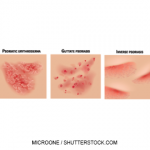Collectively, these emerging studies demonstrate that the factors and pathways regulating itch are much more heterogeneous than previously recognized (see Figure 1). This new scientific paradigm of itch biology may help us to better understand and conceptualize the different forms of itch and their potential treatments.
Emerging studies demonstrate that the factors & pathways regulating itch are much more heterogeneous than previously recognized.
Categories of Itch
Acute itch, as seen in response to arthropod bites and poison ivy, is transient in nature. In contrast, chronic itch is highly debilitating and its etiology is often difficult to define. Chronic itch, defined as lasting greater than six weeks, accompanies a number of inflammatory skin diseases, such as AD and psoriasis, as well as systemic conditions, such as CKD and cholestasis.14 The presentation of chronic itch can be divided into five different clinical categories to help organize the clinical approach, diagnosis and treatment:15
- Systemic itch;
- Neuropathic itch;
- Psychogenic itch;
- Idiopathic itch; and
- Dermatologic itch.
In this review, we briefly outline our current understanding of each category of chronic itch and its potential treatments. Further, we highlight chronic pruritus as a problem in the context of rheumatologic and autoimmune diseases. Although the five categories of chronic itch overlap at times in terms of their pathophysiology and treatments, this structure allows for a systematic and logical clinical approach (see Table 1).
Systemic Itch
The causes of systemic itch are broad and include renal failure, cholestasis and other related hepatic diseases, malignancies, endocrine disorders, systemic infection and exposure to specific drugs. Although a variety of medical conditions underlie chronic itch due to systemic causes, a common theme among these disorders is that a systemic factor is either overproduced or inadequately metabolized and excreted to mediate the itch response. In the following section, we highlight current concepts and treatments regarding a few forms of the most common causes of systemic itch.
CKD is one of the main causes of systemic itch and is often referred to as renal pruritus. Renal pruritus affects up to 58% of patients with renal failure.16 It can be either intermittent or constant and most commonly affects the back, in addition to the head, arms and abdomen.17 Although the pathophysiology is unknown, multiple hypotheses have been suggested. For example, it has been proposed that immune dysregulation underlies renal pruritus, based on the observation that patients respond to immunosuppressive light therapy.18
Beyond the immune system, the accumulation of calcium, magnesium and phosphate due to a lack of renal clearance has also been hypothesized as a contributor. In support of this, symptoms often improve following interventions that normalize electrolytes, such as parathyroidectomy.19

